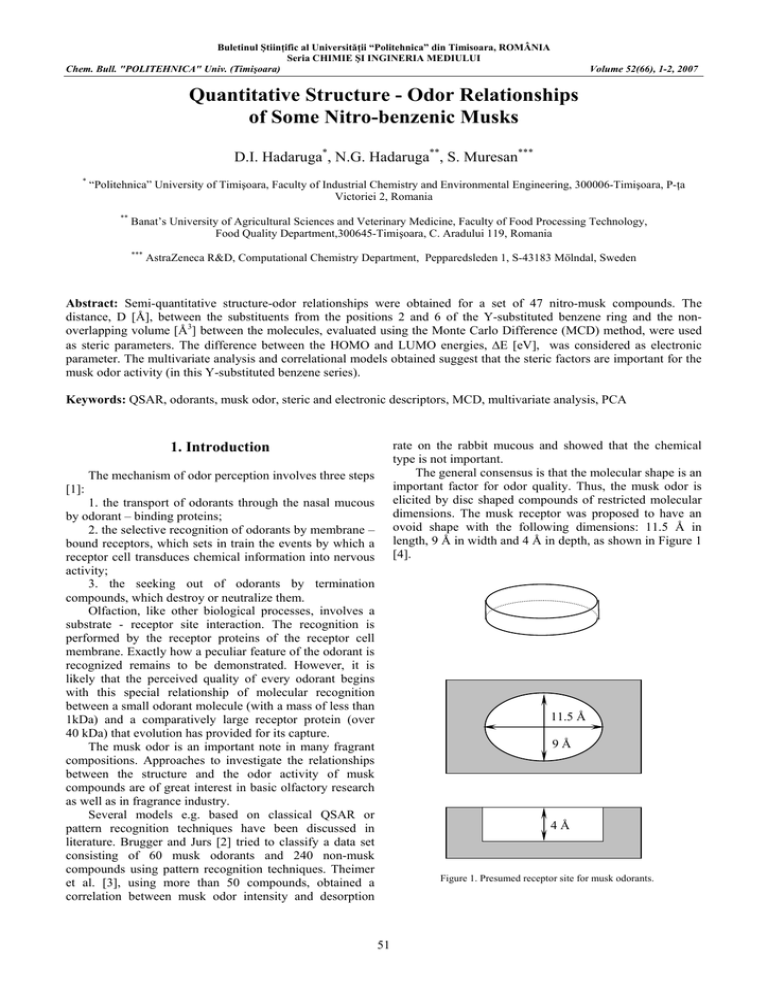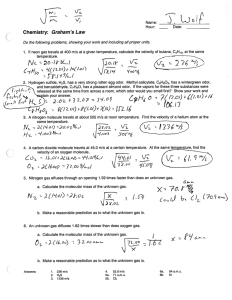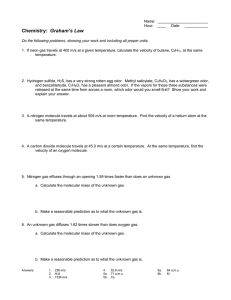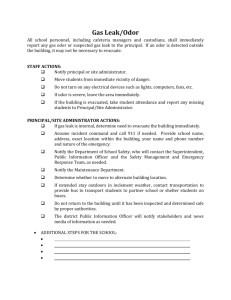Document 13359489
advertisement

Buletinul Ştiinţific al Universităţii “Politehnica” din Timisoara, ROMÂNIA Seria CHIMIE ŞI INGINERIA MEDIULUI Chem. Bull. "POLITEHNICA" Univ. (Timişoara) Volume 52(66), 1-2, 2007 Quantitative Structure - Odor Relationships of Some Nitro-benzenic Musks D.I. Hadaruga*, N.G. Hadaruga**, S. Muresan*** * “Politehnica” University of Timişoara, Faculty of Industrial Chemistry and Environmental Engineering, 300006-Timişoara, P-ţa Victoriei 2, Romania ** Banat’s University of Agricultural Sciences and Veterinary Medicine, Faculty of Food Processing Technology, Food Quality Department,300645-Timişoara, C. Aradului 119, Romania *** AstraZeneca R&D, Computational Chemistry Department, Pepparedsleden 1, S-43183 Mölndal, Sweden Abstract: Semi-quantitative structure-odor relationships were obtained for a set of 47 nitro-musk compounds. The distance, D [Å], between the substituents from the positions 2 and 6 of the Y-substituted benzene ring and the nonoverlapping volume [Å3] between the molecules, evaluated using the Monte Carlo Difference (MCD) method, were used as steric parameters. The difference between the HOMO and LUMO energies, ΔE [eV], was considered as electronic parameter. The multivariate analysis and correlational models obtained suggest that the steric factors are important for the musk odor activity (in this Y-substituted benzene series). Keywords: QSAR, odorants, musk odor, steric and electronic descriptors, MCD, multivariate analysis, PCA rate on the rabbit mucous and showed that the chemical type is not important. The general consensus is that the molecular shape is an important factor for odor quality. Thus, the musk odor is elicited by disc shaped compounds of restricted molecular dimensions. The musk receptor was proposed to have an ovoid shape with the following dimensions: 11.5 Å in length, 9 Å in width and 4 Å in depth, as shown in Figure 1 [4]. 1. Introduction The mechanism of odor perception involves three steps [1]: 1. the transport of odorants through the nasal mucous by odorant – binding proteins; 2. the selective recognition of odorants by membrane – bound receptors, which sets in train the events by which a receptor cell transduces chemical information into nervous activity; 3. the seeking out of odorants by termination compounds, which destroy or neutralize them. Olfaction, like other biological processes, involves a substrate - receptor site interaction. The recognition is performed by the receptor proteins of the receptor cell membrane. Exactly how a peculiar feature of the odorant is recognized remains to be demonstrated. However, it is likely that the perceived quality of every odorant begins with this special relationship of molecular recognition between a small odorant molecule (with a mass of less than 1kDa) and a comparatively large receptor protein (over 40 kDa) that evolution has provided for its capture. The musk odor is an important note in many fragrant compositions. Approaches to investigate the relationships between the structure and the odor activity of musk compounds are of great interest in basic olfactory research as well as in fragrance industry. Several models e.g. based on classical QSAR or pattern recognition techniques have been discussed in literature. Brugger and Jurs [2] tried to classify a data set consisting of 60 musk odorants and 240 non-musk compounds using pattern recognition techniques. Theimer et al. [3], using more than 50 compounds, obtained a correlation between musk odor intensity and desorption 11.5 Å 9Å 4Å Figure 1. Presumed receptor site for musk odorants. 51 Chem. Bull. "POLITEHNICA" Univ. (Timişoara) Volume 52(66), 1-2, 2007 Many compounds with musk odor, from different chemical classes, were discovered [5]. In 1906, H. Walbaum isolated (-)-Muscone (1) as the odorous principle of musk. It is a ketone with macrocyclic structure. Compounds as Exaltone and Civetone are also included in this class. Another class with musk odor contains macrocyclic lactones with Exaltolide (2) and Ambretholide as main representants. An important group of musk compounds are the aromatic musks such as Muskxylene (3) from the benzenic nitro-musk class, Moskene (4) from indanic nitro-musk class and 1,1,4,4,6pentamethyl-5,7-dinitrotetraline (5) from tetralinic nitromusks. The non-nitroaromatic musks were classified into five categories: benzenic, indanic, tetralinic, tricyclic, and isochromanic musks. In the first group the compound Ambral (6) has a very fine and persistent musk odor. The indanic non-nitro musks are represented by Phantolide (7) and Celestolide, and the tetralinic ones by Tonalide (8) and Versalide. The tricyclic non-nitro musk group contains tetrahydronaphthindanone derivatives, hydrindacene derivatives and acenaphthene derivatives. The last group includes the compound Galaxolide (9), as representative. The structures of these musks are depicted in Figure 2. From Figure 2 some common structural features can be seen: all musk compounds have an electron-withdrawing osmophoric group (carbonyl or nitro) and one or several bulky groups like tertbutyl. NO2 O O O H O2N 2 1 NO2 3 NO 2 NO2 H3CO CHO NO2 NO 2 4 6 5 O O O 7 9 8 Figure 2. Structures of musk compounds. In this paper we present a QSAR study for a set of N=15 nitro-benzene derivatives with musk impression. The compounds were divided in four classes: very strong, strong, weak odor and odorless, according to Teisseire [5]. The general structure of these compounds is depicted in Figure 3, and their perceived odor intensities and parameter values are presented in Table 1. In Figure 3, Y is an electron-withdrawing group such as NO2, COCH3, COCl or COOCH3 and Ri (i = 1,2,3) are alkyl groups or a halogen (see also Table 1). 52 Chem. Bull. "POLITEHNICA" Univ. (Timişoara) Volume 52(66), 1-2, 2007 Y 1 1 R 3 O2N 2 R 6 2 5 NO2 4 3 R Figure 3. The general structure of nitro-benzenic musks values are listed in Table 1, together with the square D values, used in correlations. 2. Methods 2.1. Odor descriptors It is very difficult to describe quantitatively the perceived odor characteristics; usually, only qualitative intensity degrees are indicated. In order to derive quantitative structure-odor relationships, the experimental perceived odor intensities were arbitrarily translated into numerical values. This approximation can be considered acceptable for a linear variation. experimental odor intensity quantified odor intensity very strong vs 3 strong s 2 weak w 1 odorless i <0 For the odorless compounds a value <0 was considered because these compounds have very different values for the structural parameters. This type of activity was also found in other domains, for example mutagenicity or toxicity [6]. (a) 2.2. Structural parameters All the molecular structures presented in Table 1 were optimized using the MM+ molecular field included in the HyperChem2 software [7]. Then the molecules were superposed upon musk-xylene (molecule No.1 in Table 1) such as to minimize the sum of quadratic distances between equivalent C - atoms. The result of superposition is presented in Figure 4. An inspection of Figure 4 reveals the structural characteristics that determine the perceived musk odor intensity. In Figure 4a is presented the superposed structures of compounds with very strong and strong musk odor intensity. It is easy to ascertain that the distance between the extreme atoms of substituents from positions 2 and 6 (R1 and R2) is approximately the same as compared to that weak or odorless musk compounds (Figure 4b). The substituent from position 4 (R3) has a variety of sizes along the activity series. The distance, D (Å), between the extreme heavy atoms (excluding H – atoms) of substituents R1 and R2 (see the general structure presented in Figure 3) was evaluated by an analytical calculus from the (X,Y,Z) – Cartesian coordinates of the optimized molecular structures. These (b) Figure 4. Superposition of active (a) and inactive or weak active molecules (b). The MCD (Monte Carlo Difference) method, based on minimum steric difference concept, was used to assess the steric misfit between the studied odorants. The MCD parameter was introduced in order to evaluate quantitatively the steric misfit between a receptor and its ligand. It is assumed that the biological activity (the odor intensity in this case), or ligand-receptor affinity, depends on the shape of both receptor and ligand and decreases linearly with the steric misfit between them [8]. 53 Chem. Bull. "POLITEHNICA" Univ. (Timişoara) Volume 52(66), 1-2, 2007 Within the MCD method the steric misfit is evaluated as follows [9]: the compound with the highest biological activity is chosen as standard; this molecule is considered to have a complementary geometry with respect to the receptor; all the molecules are superposed upon the standard (e.g. using a molecular modeling software). If a molecule presents several low-energy conformations the one which gives the best superposition upon the standard is selected; the MCD parameter, representing the non-overlapping volume for every pair standard-molecule, is computed using a Monte Carlo integration technique In this study the musk-xylene (compound No.1 from Table 1) was used as standard because it has a characteristic musk odor and a high structural symmetry. The difference, ΔE [eV], between the HOMO and LUMO energies, computed with the AM1 method included in the HyperChem2 program, was selected as electronic parameter. The MCD and ΔE values are presented in Table 1. TABLE 1. Nitro-benzenic musks, perceived odor intensities and structural parameters. No (i) 1. 2. 3. 4. 5. 6. 7. 8. 9. 10. 11. 12. 13. 14. 15. Y R1 R2 R3 A exp NO2 NO2 NO2 NO2 NO2 NO2 COCH3 CN COCl COOCH3 NO2 NO2 NO2 NO2 NO2 Me Br F Cl Et H Me Me Me Me H H Et nBu 3-pentil Me Me Me Me Me Me Me Me Me Me Me Me Et Me Me tBu tBu tBu tBu tBu tBu tBu tBu tBu tBu iPr secBu tBu tBu tBu vs vs vs vs s s s s s s w w i i i The correlational models were obtained using either the classical MLR or an iterative procedure using limit values. The iterative MLR procedure uses the following steps: Step 1. The experimental activities, Ai, are considered equal to the limit values. A correlational equation is $ -values are compared with established. The calculated A i the initial ones, Ai. $ -values which Step 2. For the previously calculated A i respect the input limits, the experimental value Ai is $ -values equated to the calculated one. For the calculated A i which fall in the exterior of the given limits, the limit is retained for Ai. A new correlational equation is established $ -values are calculated. and new A i Step 2 is repeated until: End. When the correlation coefficient, r, rests equal to the one for the previous step. D [Å] 5.051 5.354 4.888 5.194 5.776 3.791 4.997 5.018 5.005 5.002 3.807 3.807 6.525 8.690 6.860 D2 [Å2] 25.513 28.665 23.893 26.978 33.362 14.372 24.970 25.180 25.050 25.020 14.493 14.493 42.576 75.516 47.060 MCD [Å3] 0.000 16.212 37.598 21.742 31.664 44.446 48.628 21.522 36.124 57.580 68.078 83.532 52.679 67.787 75.284 ΔE [eV] -9.4995 -9.1717 -9.1934 -9.2706 -9.4486 -9.3126 -9.1814 -9.0700 -9.2359 -9.1968 -9.3294 -9.3131 -9.5604 -9.4408 -9.4885 A = −20.762(±4.655)+ 9.428(±1.591)⋅ D − 0.954(±0.130)⋅ D 2 N = 15;r = 0.991;s = 0.500 (1) A parabolic equation has been considered because there is an optimum D interval for the active compounds. The inactive compounds present values for this parameter either smaller or larger than this domain. The first derivative of equation (1) $ ∂A i =0 ∂D ⇒ Dopt = 4.941 Å (2) indicates an optimum distance between the R1 and R2 substituents, Dopt, of about 5 Å. Using the MCD and ΔE parameters in a classical MLR method the following equation was obtained: 3. Results and discussion The following equation (2) was obtained when D and D2 were used as structural parameters in the iterative MLR procedure. A = 31.109(±21.379) − 0.033(±0.014) ⋅ MCD + 2.999(±2.309) ⋅ ΔE N = 15, r = 0.882, s = 0.560 (3) 54 Chem. Bull. "POLITEHNICA" Univ. (Timişoara) Volume 52(66), 1-2, 2007 The statistical significance of equation (2) was not improved when the iterative MLR method was used. The experimental and calculated odor intensities, according to equations (1) and (3), are presented in Table 2. TABLE 2. Experimental and calculated odor intensities for nitro-musk compounds (equations 2 and 3 No (i) Ai exp. 1. 2. 3. 4. 5. 6. 7. 8. 3.000 3.000 3.000 3.000 2.000 2.000 2.000 2.000 $ calc. A i $ calc. A i eq. (2) 2.529 2.380 2.537 2.480 1.879 1.274 2.538 2.535 eq. (3) 2.619 3.073 2.31 2.596 1.739 1.730 1.987 3.205 No (i) Ai exp. 9. 10. 11. 12. 13. 14. 15. 2.000 2.000 1.000 1.000 0.000 0.000 0.000 $ calc. A i $ calc. A i eq. (2) 2.537 2.537 1.309 1.309 0.154 -10.847 -0.963 eq. (3) 2.231 1.649 0.909 0.454 0.718 0.584 0.197 this series require an electronic-attractive group in the close vicinity of the hydrophobic groups. 4. Conclusions The steric component as described by the MCD parameter and the D distance, is an important factor in the odorant-receptor interaction. The larger the deviation from the shape of musk-xylene, a representative musk odorant, the lower the perceived musk odor intensity. As previously shown, the distance, D, is an important structural parameter for musk activity of nitro-benzenic compounds. This value must be near to 5 Å and molecules from this class that presents a smaller or larger D value do not have musk odor. Probably, the hydrophobic interaction is significant between these points, along with the interaction of the bulky groups (with a van der Waals volume of about 70 Å3) from position 4 in the benzenic structure. The correlational model (2), which includes ΔE as an electronic parameter, suggests a possible influence of the electronic effects for the odor activity. Active molecules in REFERENCES 1. Bell, G.A., Trends in Food Science & Technology 1996, 7, 425 – 431. 2. Brugger, W.E.; Jurs, P.C., J. Agric. Food Chem. 1977, 25(5), 1158 – 1164. 3. Theimer, E.T.; Davies, J.T., J. Agric. Food Chem. 1967, 15(1), 6 – 14. 4. Ohloff, G., Scent and Fragrances. The Fascination of Odors and their Chemical Perspectives, Springer – Verlag, Berlin, 1994. 5. Teisseire, P.J., Chemistry of Fragrant Substances, VCH Publishers, Inc., New York, NY, 1994. 6. Debrath, A.K.; Lopez de Compadre, R.L.; Shusterman, A.J.; Hansch, C., Environ. Molec. Mutageneses 1992, 19, 53 – 61. 7. * * * HyperChem 2.0, Hypercube Inc. & Autodesk Inc., 1991. 8. Chiriac, A.; Ciubotariu, D.; Simon, Z., Quantitative Structure – Activity Relationships (QSAR). The MTD Method (in romanian), Ed. Mirton, Timisoara, 1996. 9. Muresan, S., Developments of the MTD method. QSAR applications, pHD Thesis, West University Timisoara, 1995. 55



